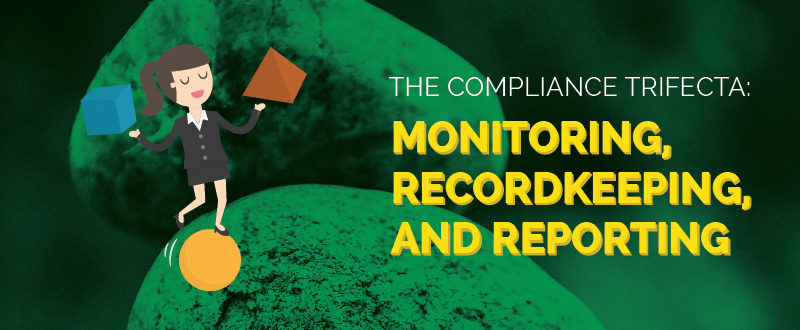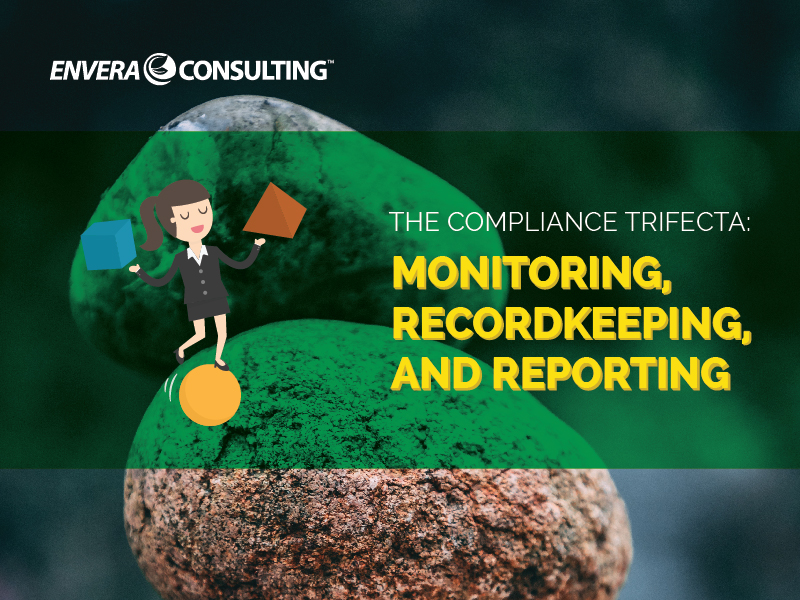

If you’ve done any work at all with air quality compliance, you’re already familiar with the three most common requirements that appear in most every rule: monitoring, recordkeeping, and reporting. At Envera, we like to refer to these as the Compliance Trifecta.
Almost every single air quality rule requires compliance in these areas. (Check out our post on how the SCAQMD structures its rules and regulations for more info.) Miss any one of those three and you could be at risk for non-compliance. Here’s the basic gist of what each member of the trifecta involves.
1. Monitoring
It’s quite common for an air quality rule to require a process to meet specific operational limits — whether it’s temperature, pressure, throughput (the amount of material being processed through a piece of equipment), or what have you. These limits are generally either outlined in a particular regulation or printed right on the face of your air permit. In order to comply with these requirements, you need to install the appropriate technology to monitor the throughput of the equipment being regulated — for example, the amount of coffee beans being roasted in a coffee roaster or the amount of natural gas combusted, in million standard cubic feet, by a boiler.
The data collected from monitoring is what is used in the second part of the trifecta.
2. Recordkeeping
“Photo or it didn’t happen.” That’s a common catchphrase on social media, but it also applies to environmental compliance, only instead of selfies, environmental compliance requires recordkeeping — and that means recording everything. Every piece of equipment needs to have associated records to verify that a particular requirement was actually met. That means keeping records of the green bean coffee roasted per month as determined by internal company production records, or the amount of natural gas combusted by the water heater per month from utility bills and/or meter readings.
How long you must keep those records depends on the regulation. Rule 109 requires facilities to keep records for two years, while Rule 1110.2 requires records on engines to be kept for five years. If you’re a facility subject to Title V of the Clean Air Act, you’re required to keep records for five years. All other facilities should check with the SCAQMD to see how long you’re required to keep your documentation. If the SCAQMD doesn’t provide a timeframe, you should determine one based on your particular business needs.
Since the rules differ by facility, it’s best to have an internal policy that ensures that all records are kept for the longest duration of all rules and regulations. Many facilities have policies in place to keep records for seven years, depending on the facility and the internal policy. (The longest agency requirement I’ve seen is five years, so that’s what I recommend. Better safe than sorry.)
3. Reporting
And now we arrive at the final member of the Compliance Trifecta. At our environmental compliance firm, reporting is where we at Envera spend most of our time, particularly during the reporting season of January to September (although it can often run later).
Every environmental compliance report comes with its own requirements and quirks, but the reports generally state such things as your calculated emissions or that you have collected the data that you are required to monitor for. Two of the requirements of Title V are a semi-annual monitoring report and an annual compliance certification, for example, while the SCAQMD requires an annual emission report (AER) from certain types of facilities. In other words, you take the data that was monitored then logged in your recordkeeping and report it all to the necessary agency. If you have a lot of reports to keep track of, check out bullet #6 in our post “19 Ways Common Environmental Compliance Problems Start” for tips on how to manage all that paperwork.
Et voilà! The trifecta is complete.